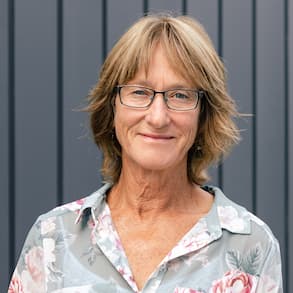Tasman water restrictions eased as veggies on the chopping block

Mike Schruer from the Tasman District Council suggested a bucket in the shower to collect water. Photo: Anne Hardie.
A bucket in the shower or scooping water out of the bath was one of the only ways many Tasman residents were allowed to water the veggie garden until Monday.
Residents in Richmond, Hope, Māpua/Ruby Bay and Redwood 1 and 2 moved to Phase E water restrictions last week, meaning water can only be used for essentials such as drinking and sanitation. Plants, including the vegetable garden, could no longer get water straight out of the tap.
However, on Saturday, Waimea Water Limited (WWL) began releasing water from the Waimea Community Dam.
Water from the reservoir was released through the smaller of three permanent dispersing valves constructed to release water from the reservoir in dry periods.
The low-level release of augmented water at the dam over the weekend enabled water restrictions for the majority of users of council-managed reticulated water supplies to be lifted with immediate effect.
This decision applies to residents in Richmond, Hope, Māpua/Ruby Bay, Brightwater, Redwood 1 and 2 as well as Nelson residents living adjacent to Champion Rd, Wakatū Industrial Estate, and parts of Saxton Rd West, where water is supplied from the Richmond Water Supply Scheme.
However those on Wakefield and Eighty-Eight Valley supplies will remain at Phase A – to help maintain water levels in the Kainui Dam at Wai-Iti - while users in Dovedale will remain at Phase D.
Tasman District Council’s waters and wastes manager, Mike Schruer, says the last time the region reached Phase E water restrictions was in 2019, the year of the Pigeon Valley fire.
The soil is now as dry on the Waimea Plains as it was through the 2018-19 drought, though river flows have been higher due to small amounts of rain higher in the catchment.
He says rainfall at Appleby is about 80 per cent of the average rainfall for the year, recorded from 1 July through to the end of February.
Last month was particularly dry with just 20 per cent of the average rainfall recorded in Richmond, which led to water restrictions.
“These restrictions are on to ensure we comply with our abstraction consents in the Delta Zone but will also extend the amount of storage we have in the aquifers for a prolonged drought. If these drop too low, we risk saltwater intrusion.”
Mike says most residents were compliant with restrictions and as they realise they can still use grey water from baths and showers to water their veggie garden and other plants, compliance is improving further.
In two weeks, WWL intends to have the remaining pipes functional to release more flow.
As the dam gets closer to completion, he says there have been many questions and opinions shared about how it works, but he says it is actually very simple.
He explains the dam’s single purpose is to maintain and support the flow of water in the rivers that recharge the aquifers and ultimately support the Waimea Plains.
Most of the water used by the urban, commercial – including horticulture – and other users on the Waimea Plains is taken using bores extracting water from the aquifers.
Until the dam is completed, he says all water users, including the council’s supply, are still subject to pre-dam consent conditions. Once completed, he says there will be a noticeable increase in how much water can be taken and in the future there will be a higher threshold for introducing water restrictions.
